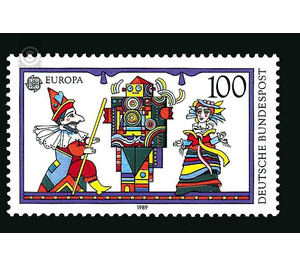Europe - Germany / Federal Republic of Germany 1989 - 100 Pfennig
Theme: Post & Philately
| Country | Germany / Federal Republic of Germany |
| Issue Date | 1989 |
| Face Value | 100.00 |
| Color | multi-colored white |
| Perforation | K 14 |
| Printing Type | Six-color offset printing |
| Stamp Type | Postage stamp |
| Item Type | Stamp |
| Chronological Issue Number | 1291 |
| Chronological Chapter | GER-BRD |
| SID | 356982 |
| In 57 Wishlists | |
The European Conference of Postal and Telecommunications Administrations (CEPT) has, within the framework of the XII. Nice Plenary Assembly in Nice as a common theme for the 1989 European brands »Children's Games«. It was recommended and preferred to give preference to games or toys that are older but still used or used by the children today. Under this general theme, the two European brands of Deutsche Bundespost show "kite flying" and "puppet theater". The oldest known pictorial traditions of a puppet theater are in an Oxford manuscript of the Alexander novel by Johann de Grise from 1344. There, two miniatures show a kind of showcase in which puppets seem to be arguing with each other. In front of the stage, the »Possenburg«, spectators can be seen. Among the ancestors of these ever-contending figures are the court jester, who had to pay for the freedom of his words with a beating, and the Turkish joker Karagoz, who had come to Europe with the Gypsies. However, the original home of puppetry is suspected in India. His spectacular protagonist is the figure of the smart Kasperle, widely known as Polichinelle, Punch, Guignol, Jan Klassen or Petrushka, in many national and regional special types across Europe. Traveling puppeteers are testimony to the 15th century. At first they probably came from Spain and France and moved as showmen all over Europe. The true heyday of European puppetry is the 18th and 19th centuries. The Viennese Johann Babtist Hilverding, who played in the 18th century with his theater in all major German cities, achieved great fame. Hilverding created the "Hanswurst" with its crude character, which became the central figure and symbol of puppet theater in southern Germany. Famous puppet theaters at the beginning of the 19th century were the stages of the director Geisselbrecht from Vienna and the original Hänneschen Theater, which was founded in 1802 by Christoph Winter in Cologne. After the First World War, artists such as Oskar Schlemmer and Paul Klee engaged in the production of theatrical puppets, and puppet theater classes were formed at the art colleges. With the Hohnsteiner hand puppet theater, founded by Max Jacob in the 1930s, and with his beaming laugh, with a hooked nose, protruding chin and blue eyes, Kasper, he shaped a new hand puppet style. Nevertheless, the Kasperl embodied as a clever successor to the Hanswurst endangered at all times principle of the good and the just, because with the freedom of the fool he glosses socially critical and without hesitation, what everyone thinks, but dares not say out loud. (Text: Sabine Fack M.A. - Toy Museum of the City of Nuremberg)


